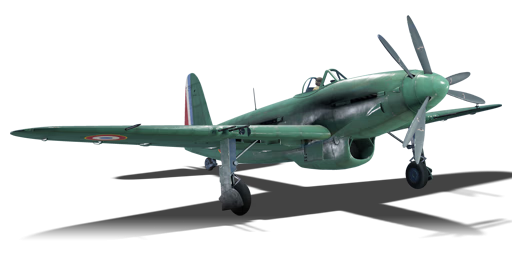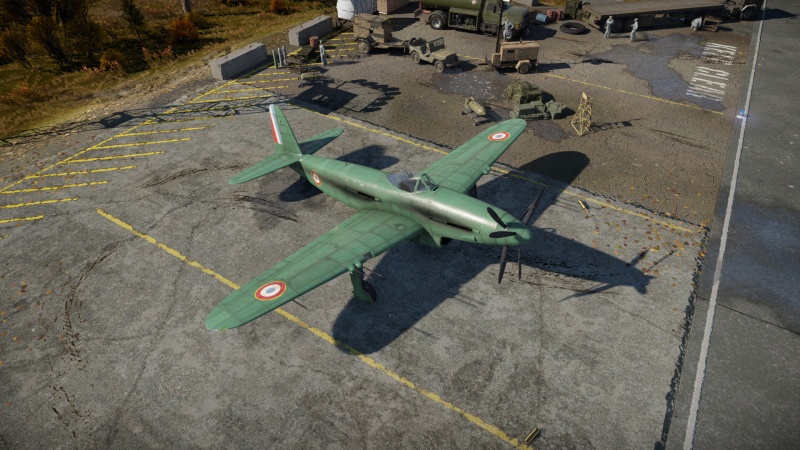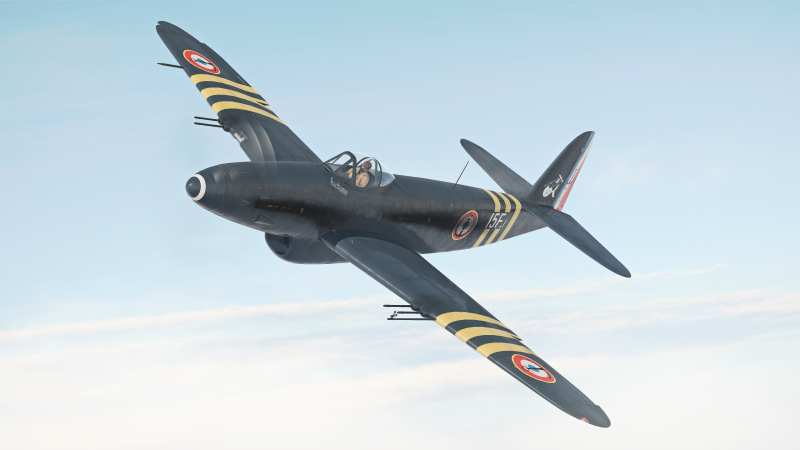Difference between revisions of "VB.10C-1"
sharmatoby1 (talk | contribs) (I added descriptions of the plane's flight performance and armament) (Tag: Visual edit) |
sharmatoby1 (talk | contribs) (I added a description of the survivability of the aircraft) (Tag: Visual edit) |
||
| Line 91: | Line 91: | ||
=== Survivability and armour === | === Survivability and armour === | ||
{{Specs-Avia-Armour}} | {{Specs-Avia-Armour}} | ||
| − | <!-- | + | <!-- The aircraft is generally quite survivable. Although there is no armour plates, only 50mm of glass in front of the pilot, the position of the engines in front of and behind the pilot provide them with a protective sandwich, meaning that they are less likely to be taken out by a stray bullet. However, the plane's tail structure is also quite weak, meaning it is vulnerable to structural damage from behind, and also to fires. --> |
* 50 mm Bulletproof glass in front and rear of the cockpit. | * 50 mm Bulletproof glass in front and rear of the cockpit. | ||
Revision as of 18:05, 1 December 2023
| This page is about the French twin-engine fighter VB.10C-1. For the other version, see VB.10-02. |
Contents
Description
The VB.10C-1 is a rank III French twin-engine fighter with a battle rating of 3.7 (AB/SB) and 4.0 (RB). It was introduced in Update 1.73 "Vive la France".
The VB.10 is a twin-engine fighter, with the second engine hidden behind the pilot driving its own set of propeller. Owing to its sleek design and contra-rotating propellers, it might appear as a single engine super-prop fighter. With 2 engines, the plane can achieve high speeds but it is heavy and does not fare well in dogfights.
General info
Flight performance
| Characteristics | Max Speed (km/h at 7,000 m) |
Max altitude (metres) |
Turn time (seconds) |
Rate of climb (metres/second) |
Take-off run (metres) | |||
|---|---|---|---|---|---|---|---|---|
| AB | RB | AB | RB | AB | RB | |||
| Stock | 679 | 659 | 11000 | 25.4 | 26.5 | 11.7 | 11.7 | 700 |
| Upgraded | 739 | 710 | 22.8 | 24.0 | 19.3 | 15.4 | ||
Details
| Features | ||||
|---|---|---|---|---|
| Combat flaps | Take-off flaps | Landing flaps | Air brakes | Arrestor gear |
| ✓ | ✓ | ✓ | X | X |
| Limits | ||||||
|---|---|---|---|---|---|---|
| Wings (km/h) | Gear (km/h) | Flaps (km/h) | Max Static G | |||
| Combat | Take-off | Landing | + | - | ||
| 820 | 450 | 498 | 469 | 320 | ~11 | ~6 |
| Optimal velocities (km/h) | |||
|---|---|---|---|
| Ailerons | Rudder | Elevators | Radiator |
| < 380 | < 380 | < 540 | > 340 |
| Compressor (RB/SB) | ||
|---|---|---|
| Setting 1 | ||
| Optimal altitude | 100% Engine power | WEP Engine power |
| 6,400 m | 1,315 hp | 1,500 hp |
Survivability and armour
- 50 mm Bulletproof glass in front and rear of the cockpit.
Modifications and economy
Armaments
Offensive armament
The VB.10C-1 is armed with:
- 4 x 20 mm Hispano 404 cannons, wing-mounted (150 rpg = 600 total)
The four cannons are arranged in bundles of two mounted in each wing. Each is armed with the same amount of ammunition, which means that all guns will fire with each other until empty.
Usage in battles
The VB.10C-1, like most heavy fighters, is reliant on side climbing to engage enemy fighters, however this isn't the only way to play the VB.10C-1, if you decide to side climb and wait for enemy planes to drop down to lower altitudes they will find themselves in peril when a experienced pilot in a VB.10C-1 comes booming past with its quick dive rate and deadly armament of 4 x 20 mm Hispano 404 cannons. The best tactic when flying solo is Boom & Zoom and play as the team's support fighter, as its great acceleration and heavy weight can allow you to make fast attacks against unsuspecting enemy fighters at lower altitudes that are pre-occupied with fighting friendly aircraft. The heavy weight can also help carry the planes speed when extending and helps retain a bit of speed when going back into a climb, be aware however that the VB.10C-1's size and weight makes it a considerable target if you happen to miss your engagement. The best tactic when flying in a group of two or more is to help teammates that are struggling in a dogfight with enemy fighters, as a large target the VB.10C-1 can distract enemy fighters and outrun most using its advantage in weight and energy which allows teammates to slide onto the enemies six o'clock and finish them off.
If you need to do a quick turn, set combat flaps and reduce the power of the engine to around 50%, then turn and close the combat flaps when half-finished with your manoeuvre. Be aware that turning in the VB.10C-1 is a way to intentionally or unintentionally bleed off any built-up energy. Conserve energy when possible in the VB.10C-1 as it lacks the capabilities to dogfight other fighters in fast or slow turning engagements.
Manual Engine Control
| MEC elements | ||||||
|---|---|---|---|---|---|---|
| Mixer | Pitch | Radiator | Supercharger | Turbocharger | ||
| Oil | Water | Type | ||||
| Controllable | Controllable Not auto controlled |
Controllable Not auto controlled |
Controllable Not auto controlled |
Separate | Not controllable 1 gear |
Not controllable |
Pros and cons
Pros:
- Very fast at all altitudes, especially in a dive
- Competitive climb rate at most altitudes
- Good turn rate for it size
- Good cockpit visibility (important for simulator battle players)
- Can fly well with one engine, improving its chance to limp back to the airfield for repairs
Cons
- The hidden rear-mounted engine can be hit by a chasing enemy
- Heavy plane, resulting into poor flat acceleration and roll rate
- Rudder is unresponsive at high speeds
- Guns are mounted far from the centre, can make lining up shot difficult
- Relatively low ammo count
History
Development
The Arsenal VB-10 was a continuation in development from the earlier VG-33 aircraft designed during the early war period but unable to be manufactured in great numbers before the Battle of France which began in May 1940.
Under the Vichy government, the prior prototypes were reconsidered, and updated designs needed to be produced. Thus, the VB-10’s distinctive design of liquid cooled tandem engines were born. This was a method of circumnavigating the lack of a 2,000 HP engine with two 1,000 HP engines[1]. The new design was higher performance than two similar American interceptor projects; the XP-62[2] and XP-67[3], the twinned engine system producing a higher top speed and competitive rates of climb and service range during a test flight in July 1945.[4]
Production
An initial order for 200 aircraft was placed after a test flight of the second prototype in September 1946 to enter service post-war, though this was reduced to 50 within three years. The first VB-10 took flight on 3rd November 1947 with Hispano-Suiza HS 12Z Ars 15/16 engines and the now standard armament for the prototype, four 20 mm cannons, replacing the prototypes' prior 23.7 mm machine guns.
The order was cancelled in September 1948 after just four of the aircraft were completed and tested. During the tests, mechanical failures caused two serious crashes, one of which was fatal and the aircraft were scrapped. The French Air Force would rely on foreign Allied fighter aircraft until the national production of jet-powered fighters began.[4]
Media
- Skins
- Videos
See also
External links
References
- Citations
- Bibliography
- Hartman, Gérard. (2007). Dossiers historiques et techniques aéronautique française. On-Line at Hydroretro.net - L’Arsenal de l’aéronautique.pdf. Retreived 13 August 2021
- Bowers, Peter. (1987). Curtiss Aircraft, 1907-1947. London: Putnam, pp.327-331. LCCN:87062882
- Francillion, René. (1988). McDonnell Douglas Aircraft Since 1920. (Vol. 2). London: Putnam Aeronautical Books, p.372. On-Line at Archive.org - McDonnel Douglas Aircraft Since 1920
- Green, William; Swanborough, Gordon. (2001). The Complete Book of Fighters: An Illustrated Encyclopedia of Every Fighter Aircraft Built and Flown. London: Salamander Books Ltd., pp. 30-31.
| Arsenal Aeronautical (Arsenal de l'Aéronautique) | |
|---|---|
| Fighters | VB.10-02 · VB.10C-1 |
| V.G.33C-1 | |
| France twin-engine fighters and strike aircraft | |
|---|---|
| Twin-engine fighters | Potez 630 · Potez 631 · VB.10C-1 · VB.10-02 |
| Strike aircraft | Br.693AB2 · ▄AD-4 · ▄AD-4NA |
| Netherlands | |
| Twin-engine fighters | ◗Fokker G.IA |
| Strike aircraft | ◘Firefly F.Mk.IV |






